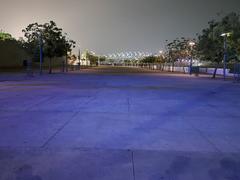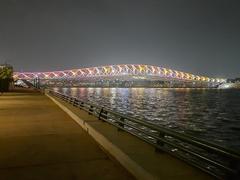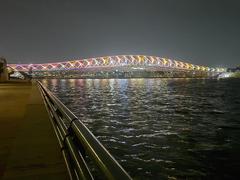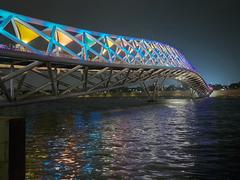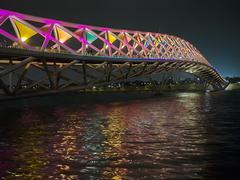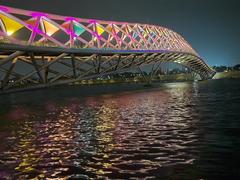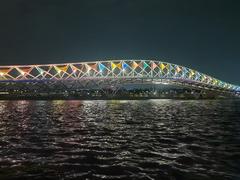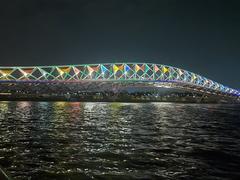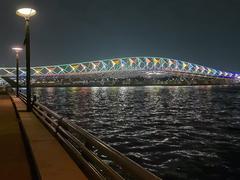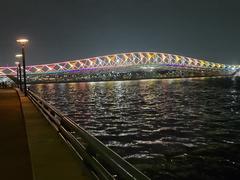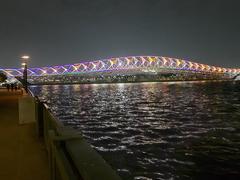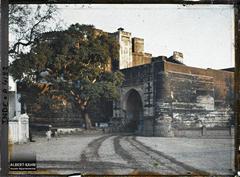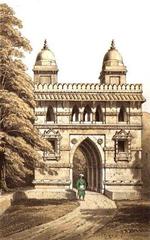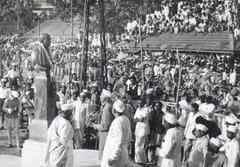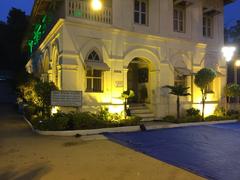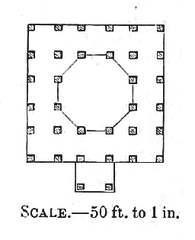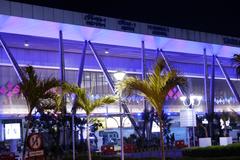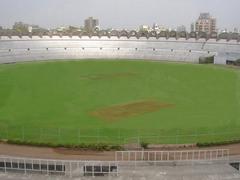
Visiting the Atal Pedestrian Bridge in Ahmedabad: Hours, Tickets, and Tips
Date: 18/07/2024
Introduction
The Atal Pedestrian Bridge, inaugurated in August 2022, stands as a testament to innovative urban design and engineering in Ahmedabad, India. Named after the former Prime Minister of India, Shri Atal Bihari Vajpayee, the bridge exemplifies a harmonious blend of historical reverence and modern aesthetics. Ahmedabad, a city known for its rich heritage and significant urban development, has long been intertwined with the Sabarmati River. The river has historically been a lifeline for trade and sustenance, playing a crucial role in the city’s growth. The Atal Pedestrian Bridge is not merely a passage over the Sabarmati; it is a strategic response to urban challenges such as traffic congestion, providing a dedicated space for pedestrians and cyclists while enhancing the city’s skyline. The design of the bridge, inspired by global architectural icons like the Sydney Harbour Bridge and London’s Helix Bridge, reflects a forward-thinking approach to infrastructure that prioritizes sustainability, aesthetics, and the well-being of its citizens. This guide delves into the history, significance, and visitor information for the Atal Pedestrian Bridge, offering a comprehensive overview for those planning to explore this architectural marvel.
Table of Contents
- Introduction
- Historical Background and Significance
- Visitor Information
- Enhancing the Urban Fabric
- Promoting Sustainable Urban Mobility
- A Catalyst for Tourism and Economic Growth
- FAQ
- A Legacy for Future Generations
- Call to Action
Historical Background and Significance
Ahmedabad’s Legacy of Bridges and Urban Development
Ahmedabad, situated on the banks of the Sabarmati River, has always held a deep connection with its waterways. Historically, the city’s growth and prosperity were intertwined with the Sabarmati, which served as a vital trade route and a source of life. Over the centuries, Ahmedabad has witnessed the construction of numerous bridges, each reflecting the architectural styles and engineering prowess of its time. These bridges, more than just physical connectors, have served as symbols of progress, connecting communities and fostering economic growth.
The Vision Behind the Atal Pedestrian Bridge
The Atal Pedestrian Bridge embodies a forward-looking approach to urban development, emphasizing sustainability, aesthetics, and citizen-centric design. The bridge was conceived as a solution to the growing traffic congestion in Ahmedabad, aiming to provide an alternative mode of transportation for pedestrians and cyclists. Beyond its functional purpose, the bridge was envisioned as a landmark structure, enhancing the city’s skyline and creating a vibrant public space.
A Symbol of Progress and Connectivity
The Atal Pedestrian Bridge represents a harmonious blend of history and modernity. It stands as a symbol of Ahmedabad’s journey from a historic trading hub to a modern metropolis, embracing innovation while preserving its heritage. The bridge’s design, inspired by the iconic Sydney Harbour Bridge and London’s Helix Bridge, reflects a global outlook and a commitment to creating world-class infrastructure.
Visitor Information
Visiting Hours and Tickets
The Atal Pedestrian Bridge is open to visitors daily from 6:00 AM to 10:00 PM. Entry is free, but guided tours are available for a nominal fee. It is advisable to check the official website for any updates on visiting hours or special events.
Travel Tips
- Best Time to Visit: Early mornings and evenings offer the most comfortable temperatures and best lighting for photography.
- What to Wear: Comfortable walking shoes and weather-appropriate clothing.
- Safety: The bridge is well-lit and monitored, but it’s always best to stay vigilant.
Nearby Attractions
- Sabarmati Ashram: A short walk from the bridge, this historic site offers a glimpse into Mahatma Gandhi’s life and work.
- Kankaria Lake: Another popular spot for leisure and recreation, offering boating, a zoo, and other attractions.
- Sardar Patel Stadium: For sports enthusiasts, this iconic cricket stadium is a must-visit.
Enhancing the Urban Fabric
The Atal Pedestrian Bridge has not only eased traffic congestion but also breathed new life into the Sabarmati Riverfront. The bridge has become a popular destination for residents and tourists alike, offering stunning views of the river and the city. Its presence has spurred the development of recreational spaces, cafes, and cultural hubs along the riverfront, transforming it into a vibrant public realm.
Promoting Sustainable Urban Mobility
The Atal Pedestrian Bridge aligns with Ahmedabad’s commitment to sustainable urban mobility. By providing a dedicated space for pedestrians and cyclists, the bridge encourages non-motorized transport, reducing traffic congestion and promoting a healthier lifestyle. The bridge’s energy-efficient design, incorporating solar panels and LED lighting, further underscores its eco-friendly credentials.
A Catalyst for Tourism and Economic Growth
The Atal Pedestrian Bridge has become a major tourist attraction in Ahmedabad, drawing visitors from across India and beyond. Its unique design and picturesque setting have made it a popular spot for photography and leisure activities. The bridge’s presence has contributed to the growth of tourism in the city, boosting the local economy and creating employment opportunities.
FAQ
Q: What are the Atal Pedestrian Bridge visiting hours? A: The bridge is open daily from 6:00 AM to 10:00 PM.
Q: Is there an entry fee for the Atal Pedestrian Bridge? A: Entry is free, but guided tours are available for a nominal fee.
Q: What are some nearby attractions? A: Sabarmati Ashram, Kankaria Lake, and Sardar Patel Stadium are all nearby.
A Legacy for Future Generations
The Atal Pedestrian Bridge stands as a testament to Ahmedabad’s vision and its commitment to creating a sustainable and vibrant urban environment. The bridge serves as an inspiration for other cities, demonstrating how infrastructure can be both functional and aesthetically pleasing, enhancing the quality of life for residents and visitors alike. The Atal Pedestrian Bridge is not just a bridge; it is a symbol of progress, connectivity, and a brighter future for Ahmedabad.
Call to Action
For more updates and information, download the Audiala mobile app, check out other related posts, or follow us on social media.
References
- Visiting the Atal Pedestrian Bridge in Ahmedabad - History, Significance, and Visitor Information, 2024 (source)
- Exploring the Atal Pedestrian Bridge - Design, History, and Visitor Information, 2024 (source)
- Complete Guide to Visiting the Atal Pedestrian Bridge in Ahmedabad - Timings, Tickets, and Tips, 2024 (source)
